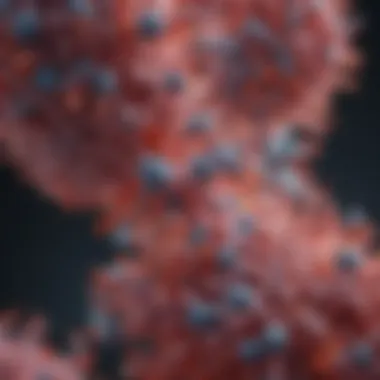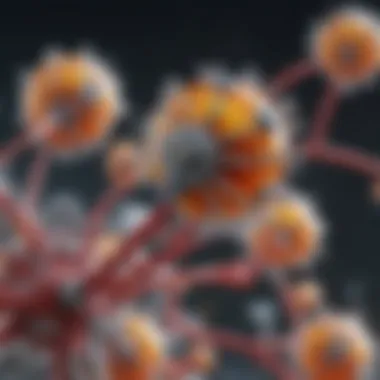In-Depth Insights into BRD Inhibitors and Their Impact


Intro
Bromodomain (BRD) inhibitors have emerged as significant players in the realm of pharmaceutical development and therapeutic advancements. Understanding their impact on biological processes can provide critical insights for future treatments in various diseases. This analysis aims to dissect the mechanisms of action of BRD inhibitors, their structural characteristics, current research trends, and the challenges faced in the field.
Key Concepts
Definition of the Main Idea
Bromodomains are protein interaction modules that recognize acetylated lysine residues on histones and non-histone proteins. As such, BRD inhibitors are designed to disrupt this interaction, which can modulate gene expression. By inhibiting BRD proteins, therapies can potentially influence epigenetic regulation and impact cellular functions.
Overview of Scientific Principles
BRD proteins play a key role in numerous biological processes, including DNA repair, cell cycle regulation, and transcriptional control. The primary function of BRD inhibitors is to block the interaction between BRD proteins and acetylated lysines. This blockade can lead to altered gene expression, impacting various signaling pathways associated with diseases, particularly cancers. The structural complexity of BRD proteins presents challenges but also opportunities for the development of targeted therapies.
Current Research Trends
Recent Studies and Findings
Recent studies indicate a growing appreciation for the therapeutic potential of BRD inhibitors. For instance, research conducted by Zhang et al. emphasizes the efficacy of compounds like JQ1 in inhibiting BRD4 and its role in treating hematological malignancies. Various clinical trials are ongoing, exploring the potential of these inhibitors in combination therapies.
Significant Breakthroughs in the Field
The identification of selective BRD inhibitors has revolutionized our understanding of epigenetic regulation. Breakthroughs in chemical biology, particularly the development of small-molecule inhibitors, have provided new avenues for treating diseases that involve transcriptional dysregulation. These advances have opened the door for leveraging BRD inhibitors as effective therapeutic agents.
Inhibiting bromodomain proteins is a new strategy that could reshape therapeutic interventions against multiple forms of cancer and other diseases.
Inhibiting bromodomain proteins is a new strategy that could reshape therapeutic interventions against multiple forms of cancer and other diseases.
Closure
The exploration of BRD inhibitors presents vast possibilities for innovative therapeutic strategies. Understanding their mechanisms, the ongoing research, and breakthroughs is essential for realizing their potential in clinical applications. As the scientific community continues to delve deeper into the roles of BRD inhibitors, their impact may fundamentally alter modern therapeutics and offer new hope in battling complex diseases.
Foreword to BRD Inhibitors
Bromodomain inhibitors (BRD inhibitors) represent a captivating area of research with significant implications in various fields, including molecular biology and therapeutic development. Understanding their mechanism of action, potential applications, and the challenges faced in this domain is crucial for students, researchers, educators, and professionals alike. The increasing interest in BRD inhibitors stems from their role in regulating gene expression through epigenetic mechanisms. Moreover, their potential in treating various diseases, including cancer and inflammatory conditions, highlights their importance in modern therapeutic strategies.
Definition and Overview
BRD inhibitors are small molecules that target bromodomain-containing proteins, primarily involved in recognizing acetylated lysine residues on histones. These interactions play a critical role in the modulation of chromatin structure and gene expression. By inhibiting these interactions, BRD inhibitors can alter the regulation of genes associated with several diseases. The significance of these compounds cannot be understated as they provide a tool for understanding complex biological processes and may lead to new treatment paradigms.
Historical Context and Development
The journey of BRD inhibitors began with the discovery of bromodomains in the early 1990s. Initially, research focused on the structure and function of these domains, revealing their vital role in the transcriptional regulation landscape. Years of investigation led to the identification of several BRD-containing proteins, such as BET family proteins. The advent of high-throughput screening methods in the early 2000s paved the way for the development of small-molecule inhibitors designed to target these proteins.
As research progressed, the potential therapeutic applications of BRD inhibitors began to emerge, particularly in cancer treatment. Several compounds entered clinical trials, marking a new chapter in the quest for effective cancer therapies. The history of BRD inhibitors is still unfolding, with ongoing studies aiming to optimize their specificity and effectiveness, paving the way for future innovations in drug development.
"BRD inhibitors stand at the forefront of epigenetic research, offering hope where traditional therapies have failed."
"BRD inhibitors stand at the forefront of epigenetic research, offering hope where traditional therapies have failed."
Bromodomain Structure and Function
Bromodomains are specialized protein interaction modules that recognize acetylated lysine residues on histones and other proteins. They play an essential role in the regulation of various biological processes, including gene expression, cell cycle progression, and response to cellular stress. Understanding the structure and function of bromodomains is crucial for grasping how bromodomain inhibitors can modulate these processes, ultimately impacting therapeutic strategies in diseases where epigenetic regulation is altered.
Molecular Design and Types
The molecular design of bromodomains is characterized by a particular structural fold. Most bromodomains consist of about 110-130 amino acids, forming a left-handed helical bundle structure. This design allows for the specific recognition of acetyl-lysine residues through its binding pocket. There are typically two types of bromodomains: canonical and non-canonical.


- Canonical Bromodomains: Typically possess a highly conserved sequence and structure, found in various proteins involved in transcriptional regulation.
- Non-canonical Bromodomains: Show greater variability in sequences and structures, often influencing diverse cellular functions beyond transcription.
The interaction between bromodomains and their acetylated targets is critical for the recruitment of protein complexes that modify chromatin. This interaction is linked to processes such as transcriptional activation and silencing, making bromodomain inhibitors a potent tool in therapeutic applications.
Biological Roles and Mechanisms
Bromodomains facilitate a range of biological roles that include but are not limited to the following:
- Gene Regulation: Bromodomains modulate transcriptional activity by recruiting transcription factors and co-activators to acetylated histones, enhancing gene expression.
- Chromatin Remodeling: These domains contribute to the structural rearrangement of chromatin, allowing for the appropriate access of transcription machinery to DNA.
- Signal Transduction: Bromodomain-containing proteins are involved in cellular signaling pathways that respond to various stimuli.
"Bromodomains serve as crucial interpreters of the histone code, connecting the epigenetic marks on DNA to transcriptional outcomes."
"Bromodomains serve as crucial interpreters of the histone code, connecting the epigenetic marks on DNA to transcriptional outcomes."
The mechanisms employed by bromodomains in these roles tie closely to their ability to read the acetylation marks on lysine residues. Such readout capabilities underline the significance of these domains in maintaining cellular homeostasis. Furthermore, perturbations in bromodomain function or regulation can lead to pathological states, including cancer. Hence, studying their biological roles is vital for understanding therapeutic avenues involving BRD inhibitors.
Mechanism of Action of BRD Inhibitors
Understanding the mechanism of action of BRD inhibitors is critical for grasping their relevance in biological and therapeutic contexts. These small molecules target bromodomains, which are critical for the recognition of acetylated lysines on histone and non-histone proteins. By interacting with these domains, BRD inhibitors can modulate various biochemical pathways, leading to altered gene expression and ultimately influencing cell behavior. This section will detail how these agents interact with their proteins and the broader implications of those interactions on gene regulation.
Interaction with Target Proteins
BRD inhibitors specifically disrupt the binding between bromodomain-containing proteins and acetylated lysine residues. This interaction is essential for the recruitment of chromatin remodeling complexes and transcriptional co-activators.
By blocking this binding, BRD inhibitors can effectively downregulate the expression of certain genes that promote oncogenesis or inflammatory processes. The selectivity of these inhibitors is paramount. Some inhibitors are highly selective for specific bromodomains, while others may target multiple bromodomain family members.
"The diverse nature of bromodomains allows for varying degrees of interaction among inhibitors, leading to distinct biological outcomes."
"The diverse nature of bromodomains allows for varying degrees of interaction among inhibitors, leading to distinct biological outcomes."
For example, compounds like JQ1 have shown to inhibit BRD4, a protein linked to acute myeloid leukemia, demonstrating the therapeutic potential locked within these classes of drugs. When choosing a BRD inhibitor for a particular therapeutic goal, understanding its selectivity and the specific proteins it may interact with is essential for predicting outcomes in clinical settings.
Impact on Gene Regulation
Gene regulation is intricately linked to cellular functions such as differentiation, proliferation, and response to external stimuli. BRD inhibitors, by obstructing the interaction between bromodomains and acetylated lysines, significantly influence epigenetic regulation.
One key effect of BRD inhibition is the alteration of transcriptional landscapes. When BRD proteins are inhibited, associated gene programs may be activated or silenced, depending on the cellular context. This is particularly relevant in cancer treatments, where inhibiting oncogenic signaling pathways can shift the balance towards apoptosis in malignant cells.
Furthermore, these inhibitors can restore normal regulatory mechanisms that may be disrupted in diseases. Changes in gene expression patterns managed by BRD inhibitors can lead to broader implications across different biological systems, promoting the investigation of these compounds in therapeutic applications beyond oncology.
In summary, the mechanism of action of BRD inhibitors is vital to their function as therapeutic agents. As research progresses, a more refined understanding of protein interactions and gene regulation will undoubtedly enhance the development of more effective and targeted treatments.
Therapeutic Applications of BRD Inhibitors
The therapeutic application of bromodomain (BRD) inhibitors encompasses various disease contexts, which is a key area of focus in this analysis. Given the role of BRD proteins in diverse biological processes including gene regulation, BRD inhibitors offer a promising avenue in modern therapeutics. Researchers are increasingly investigating how these compounds can influence cellular mechanisms, providing insights into potential treatments for serious conditions such as cancer, inflammatory diseases, and neurological disorders.
Cancer Treatment Insights
Cancer remains one of the leading causes of death worldwide, and the search for effective treatments is ongoing. BRD inhibitors have emerged as a notable option in oncology. They work primarily by modulating epigenetic factors, affecting the expression of genes that drive tumor growth and survival.
A variety of BRD inhibitors have shown efficacy in preclinical and clinical trials. For instance, compounds like JQ1 and OTX015 demonstrate the ability to interrupt the interaction between BRD2, BRD3, and BRD4 with acetylated histones. This action can lead to the downregulation of oncogenes such as MYC, which is frequently overexpressed in numerous cancers.
In recent studies, combination therapies involving BRD inhibitors and other chemotherapeutics have been evaluated. These combinations aim to expand the therapeutic window and enhance the overall efficacy of treatment regimens. This dual approach may provide more effective means to combat malignancies that exhibit resistance to traditional modalities.
Role in Inflammatory Diseases
Beyond oncology, BRD inhibitors are gaining traction in the landscape of inflammatory diseases. Chronic inflammation is a crucial factor in the pathogenesis of many conditions, including rheumatoid arthritis and inflammatory bowel disease. Here, the inhibition of specific bromodomain-containing proteins may play a pivotal role in modulating inflammatory pathways.
Certain studies have detailed how BRD inhibitors can reduce the expression of inflammatory cytokines such as TNF-alpha and IL-6. By doing so, they may alleviate symptoms and slow disease progression. For instance, compounds like I-BET151 have shown potential in addressing autoimmune conditions by inhibiting the binding of BRD proteins to acetylated lysines on histones, thus reducing inflammation at the cellular level.


Applications in Neurological Disorders
The application of BRD inhibitors in neurological disorders is an evolving field that warrants attention. Conditions such as Alzheimer's disease and Huntington's disease are associated with dysregulated gene expression, which can lead to disease progression and neuronal damage. BRD inhibitors offer a unique method to address these issues by targeting the epigenetic regulation of genes involved in neuronal function and survival.
Research has provided evidence that BRD inhibitors can promote neuroprotection or enhance cognitive functions through their effects on specific signaling pathways. For example, inhibiting BRD4 has shown promise in neural stem cell differentiation, which could ultimately help in neuroregeneration efforts.
"The intersection of epigenetics and neurological health presents an untapped frontier for BRD inhibitor applications."
"The intersection of epigenetics and neurological health presents an untapped frontier for BRD inhibitor applications."
Current Research Landscape
The research landscape surrounding bromodomain (BRD) inhibitors is both vibrant and rapidly evolving. This section examines various contemporary studies that highlight the innovative approaches adopted by researchers. The importance of this topic lies in its potential to reveal the mechanisms through which BRD inhibitors can be effectively utilized in therapeutic contexts, along with insights into their limitations and opportunities.
Overview of Recent Studies
Recent academic investigations have focused on several key areas relating to BRD inhibitors. For instance, studies utilizing high-throughput screening methods have enabled the identification of novel BRD inhibitors with enhanced selectivity. Researchers have explored the role of BRD4 in oncogenesis, particularly in different types of cancers such as leukemia and breast cancer. These findings are significant as they inform targeted therapy development.
Moreover, investigations into the combinatorial use of BRD inhibitors with other therapeutic agents have expanded. This synergistic approach aims to enhance efficacy while minimizing potential resistance mechanisms. Many clinical studies are currently underway to validate the effectiveness of these combination therapies in vivo.
Key studies to note include:
- Exploration of BRD inhibition in hematological malignancies.
- Research on specific BRD inhibitor candidates like JQ1 and its potential effects on transcriptional programs linked to cancer.
- Investigations into the impact of BRD inhibitors on inflammatory pathways, highlighting potential utility in auto-immune diseases.
Key Findings and Implications
The findings emerging from recent research underscore several implications for future investigations and clinical applications of BRD inhibitors. Noteworthy outcomes include:
- Selective Inhibition: The advancement in understanding the structure-activity relationship of BRD inhibitors facilitates the design of more selective compounds.
- Epigenetic Regulation: Insights into how BRD4 influences gene expression bolster the hypothesis that manipulating epigenetic regulatory mechanisms can yield significant therapeutic benefits.
- Resistance Mechanisms: A critical observation is the emergence of resistance to BRD inhibitors in some contexts, prompting the need to develop strategies to counteract this challenge. Ongoing research aims to decode the molecular basis of resistance, which is essential for the design of combination therapies.
"The evolving research landscape emphasizes both the promise and challenges faced in the therapeutic applications of BRD inhibitors. Understanding key findings informs future studies and clinical practices."
"The evolving research landscape emphasizes both the promise and challenges faced in the therapeutic applications of BRD inhibitors. Understanding key findings informs future studies and clinical practices."
Clinical Trials Involving BRD Inhibitors
Clinical trials represent a critical phase in the evaluation and validation of bromodomain (BRD) inhibitors. These trials provide a systematic way to assess the efficacy and safety of new therapies. Understanding clinical trials' structure is essential for establishing BRD inhibitors as viable treatment options. These trials often determine the real-world applicability of the scientific findings from laboratory research.
Overview of Ongoing Trials
Currently, there are several prominent clinical trials focusing on BRD inhibitors, exploring their potential in various therapeutic areas. For instance, trials such as the ones involving JQ1, a well-known BRD inhibitor, have aimed to evaluate its efficacy in treating different types of cancers, including hematological malignancies and solid tumors. The inclusion of patients with specific genetic profiles may help in understanding which patient populations are most likely to benefit from this treatment.
Moreover, other ongoing trials assess the impact of BRD inhibitors like ABBV-181 and CPI-0610 in combination therapies. This combination approach seeks to enhance treatment effectiveness and potentially overcome resistance mechanisms inherent in some cancers. The results of these ongoing trials are awaited with great interest, as they promise to shed light on crucial aspects of BRD inhibitors and their broader implications for therapy.
Challenges Faced in Trials
While clinical trials for BRD inhibitors hold much promise, they are not without significant challenges. One major concern is the selective targeting of BRD proteins without affecting other pathways. This selectivity is vital because non-specific inhibition can lead to unintended side effects, complicating patient outcomes.
Furthermore, resistance mechanisms are emerging as a crucial hurdle in clinical trials. Some cancer cells can develop alternatives to bypass the effects of BRD inhibitors. Identifying these mechanisms is essential for developing strategies to counteract them.
"Understanding the challenges faced in clinical trials for BRD inhibitors is as important as the successes, as these hurdles will shape future research pathways."
"Understanding the challenges faced in clinical trials for BRD inhibitors is as important as the successes, as these hurdles will shape future research pathways."
In addition to biological challenges, logistical issues also impact clinical trials. Recruitment of suitable participants can be difficult due to stringent eligibility criteria. This aspect is particularly relevant in cancer studies where specific genetic or molecular markers are required for enrollment. The formulation of ideal inclusion criteria can sometimes hinder rapid patient enrollment, introducing delays in study timelines.
Thus, while the exploration of clinical trials involving BRD inhibitors is a promising frontier in medicine, it is essential to recognize and address the multifaceted challenges that accompany this process.
Challenges in BRD Inhibitor Research


The development of BRD inhibitors has the potential to revolutionize therapeutic strategies across a broad spectrum of diseases. However, this field is not without its impediments. Understanding these challenges is vital in guiding future research and development efforts. This section delves into two major challenges encountered in the study of BRD inhibitors: selectivity and specificity issues, and resistance mechanisms in target cells.
Selectivity and Specificity Issues
One of the primary hurdles in BRD inhibitor development is achieving a desirable balance between selectivity and specificity. Given the structural similarities between different bromodomains, a significant challenge arises in designing inhibitors that effectively target a distinct bromodomain without affecting others. Non-specific binding can lead to off-target effects, which may result in unwanted side effects or reduced efficacy in therapeutic applications.
- Drug Design Complications: The overlapping structural features call for sophisticated drug design strategies that seek to enhance selectivity. In many cases, high-throughput screening of compound libraries has been employed, yet the success rate remains variable.
- Biological Variability: Biological systems are complex, and the expression profile of bromodomains can vary significantly across different tissues and disease states. Thus, an inhibitor that shows promise in vitro may not necessarily replicate the same efficacy in vivo, leading to additional scrutiny in the characterization stage.
The implications of selectivity are significant. Inhibitors that lack specificity can initiate a cascade of unintended biological consequences that may overshadow the intended therapeutic effects. Researchers must employ rational drug design principles while considering the overall biological state when developing these inhibitors.
Resistance Mechanisms in Target Cells
As with many therapeutic agents, BRD inhibitors face the challenge of resistance mechanisms that can significantly impede their effectiveness over time. Cancer cells, in particular, exhibit extraordinary adaptability, leading to situations where initial responses to inhibitors are transient.
- Genetic Mutations: One common pathway to resistance involves genetic mutations within the target proteins. Such mutations can lead to conformational changes in bromodomains, diminishing the binding affinity of inhibitors and thereby facilitating continued cellular growth.
- Epigenetic Modifications: In addition to genetic alterations, epigenetic changes can also contribute to resistance. These modifications can alter the expression of target genes or create alternative signaling pathways that bypass the need for bromodomain activity.
This resistance not only complicates treatment regimens but also necessitates a deeper understanding of the molecular dynamics at play. By dissecting these mechanisms, researchers aim to predict and overcome resistance, leading to the development of combination therapies that might mitigate such effects.
"Navigating the landscape of BRD inhibitor research requires both precision and adaptability, as the challenges of selectivity and resistance continue to evolve."
"Navigating the landscape of BRD inhibitor research requires both precision and adaptability, as the challenges of selectivity and resistance continue to evolve."
In light of these challenges, continued innovation in drug design, alongside an emphasis on understanding the underlying biological systems, is essential. Bridging the gap between the promise of BRD inhibitors and their practical application will require concerted efforts across multiple disciplines.
Future Directions in BRD Inhibitor Development
The exploration of future directions in bromodomain (BRD) inhibitor development is crucial. This section will outline various innovative approaches and considerations that may transform research and therapeutic applications. As scientists delve deeper into the structures and functions of BRD proteins, it becomes apparent that there are numerous strategies on the horizon. Focus on these strategies will enhance our understanding and implementation of BRD inhibitors.
Emerging Strategies in Drug Design
The landscape of drug design is rapidly evolving. New technologies and methodologies are now in play that greatly enhances the potential for developing effective BRD inhibitors. For example, advanced computational tools facilitate the identification of novel chemical scaffolds that can selectively inhibit bromodomains. This approach allows researchers to rapidly screen large libraries of compounds with minimal resources.
Structure-based drug design, leveraging structural data from crystallography, is becoming more prominent. By understanding the conformation of BRD proteins, scientists can rationally design inhibitors that fit precisely into their active sites.
Furthermore, fragment-based lead discovery provides a powerful way to create inhibitors. This strategy involves screening smaller fragments that can bind to the target protein. Once a fragment is found, it can be elaborated into a more potent compound.
With these emerging strategies, the specificity and efficacy of BRD inhibitors can be substantially improved, which could prove vital in clinical settings.
Potential for Combination Therapies
Combination therapies offer a promising future for BRD inhibitors. The rationale is straightforward: while BRD inhibitors target epigenetic regulation, combining them with other agents could yield synergistic effects. This is particularly relevant in complex diseases like cancer, where multiple pathways often drive tumor progression.
Current studies indicate that pairing BRD inhibitors with traditional chemotherapy or targeted therapies might eliminate cancer cells more effectively. For instance, combining BRD inhibitors with agents like venetoclax, which targets BCL-2, presents potential for overcoming resistance in certain cancers.
Moreover, exploring the combination of BRD inhibitors with immunotherapeutics opens new avenues. This combination could potentially enhance the immune response against tumors, leading to more robust treatment outcomes.
"Combining BRD inhibitors with other therapeutic agents may revolutionize treatment paradigms for complex diseases."
"Combining BRD inhibitors with other therapeutic agents may revolutionize treatment paradigms for complex diseases."
As these therapies move forward through clinical trials, ongoing research will continue to refine the combinations that yield the best outcomes, ensuring that these developments remain at the cutting edge of medical science.
The End
The conclusion of this article underscores the vital role and transformative potential of bromodomain (BRD) inhibitors across various fields of research and therapy. As our understanding of the intricate mechanisms of gene regulation continues to grow, BRD inhibitors emerge as significant players in modulating epigenetic processes. Their unique ability to influence critical biological pathways makes them valuable in developing innovative treatment strategies for diverse conditions, from cancer to inflammatory diseases.
Summary of Key Takeaways
- BRD inhibitors interact specifically with bromodomains, impacting gene expression and regulation.
- They hold promise in therapeutic applications, especially in oncology and neurodegenerative diseases.
- Ongoing clinical trials are crucial for determining the safety, efficacy, and potential side effects of BRD inhibitors.
- Challenges such as selectivity and resistance need addressing to enhance their therapeutic efficacy.
- Future research and development are directed toward combination therapies and novel drug design strategies.
Final Thoughts on the Importance of BRD Inhibitors
In a landscape where traditional treatment options are often limited, BRD inhibitors offer a fresh perspective on tackling complex diseases. Their involvement in epigenetic regulation lays a robust foundation for future therapeutic approaches. Researchers, educators, and students alike should be focused on these inhibitors as they represent a frontier of modern science merging basic biology with therapeutic innovation.
Understanding and exploring BRD inhibitors are not just academically relevant; they are pivotal in reshaping how we approach diseases that have long been challenging to treat. The journey into BRD inhibitors signifies an important stride towards better healthcare outcomes and enhanced therapeutic modalities.







